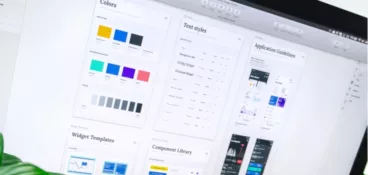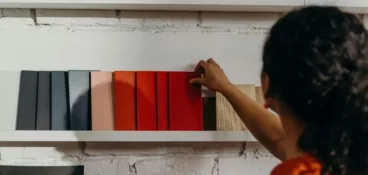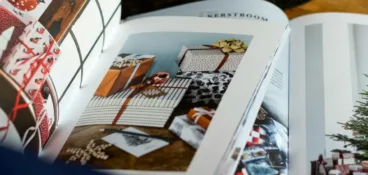The humble brochure has been used for centuries. And despite the rising popularity of digital marketing, brochures are still one of the best types of marketing collateral to tell your brand’s story and connect with potential customers. When done right, that is …
All too often, companies rush to create and print brochures with little craft or consideration. This is a big mistake and a missed opportunity for businesses, as one shoddy brochure can leave a lasting, negative impression on your target audience.
In this article, I’m going to take you through the entire process of how to make your own brochure. After we look at each step of the process, I’ll share some extra tips you can use to make sure your brochures stand out every time.
But before that, let’s take a closer look at what a brochure is and all the different ways you can use this print material to supercharge your business.
Supercharge your marketing reviews
Share, review, and approve all your content in one place with Filestage.
What is a brochure?
A brochure is a printed marketing or promotional material used by businesses and organizations to convey information about their products, services, or brand.
Brochures are typically printed on paper and folded into a compact format so they can be distributed easily (we’ll come back to this shortly). These print materials usually include a combination of text, images, and graphics designed to attract attention and share relevant details with the reader.
Business brochures can serve a variety of purposes, including:
- Product or service marketing
- Event promotion
- Brand awareness
- Educational content
- Tourism and travel guides
As well as being quick and cost-effective to produce, brochures give businesses an opportunity to directly target their audience by displaying or distributing them in specific places. For example: direct mail, in-store displays, trade shows, and events.
The tangible, handheld nature of brochures also helps create a more memorable connection with your audience. All going well, customers will take your brochure with them for future reference, which extends the reach and longevity of your marketing efforts too.
How to make a brochure
Now that we know what a brochure is and the different benefits it has for business, it’s time to get to work! In this section, we’ll look at how to make an effective brochure in seven simple steps.
1. Define the purpose of your brochure
Before you get stuck into the creative process of brochure design, you first need to determine exactly what you want to achieve with your brochure.
Setting a clear, single-minded goal for every brochure you make will keep your team on the right track, from messaging through to the final design. Whether you want to promote a product, announce an event, or educate your customers, it’s important to align every individual element with the overall purpose of your brochure.
If you work in a design or marketing agency, start by asking your clients why they need a new brochure and what their objectives are. If they’ve given you a creative brief to work from, it’s good practice to take a step back and take the time to find out exactly what it is they’re hoping to achieve.
Outlining your purpose ahead of time will set you up to create a compelling brochure that drives meaningful engagement and resonates with your customers.
Which brings me onto the next step …
2. Understand your customer
The last thing you want is to spend time and money creating a brochure that doesn’t click with your customers. That’s why understanding your audience is a must.
At this stage, you probably have at least a general idea of who you’re talking to. But it’s important to fill in any knowledge gaps by thoroughly researching your audience’s preferences, behaviors, and needs. You can use a buyer persona template to help structure your findings.
When you’re able to paint a picture of your audience in this way, you’ll be much better equipped to address their pain points and motivate them to take action with a brochure that truly hits the mark.
3. Outline the content of your brochure
Once you’ve got a clear understanding of the purpose of your brochure and who you’re sharing it with, it’s time to create an outline of the content you want to include.
This step is all about determining the key points you want to communicate with your brochure. These could include product features, benefits, unique selling points, or your brand story. It’s not a bad shout to gather up the graphics and imagery you plan to use at this point too.
Breaking your content down into sections and prioritizing your topics will help you stay organized and collaborate with your team for a seamless creative workflow. It also means you won’t have to start from a completely blank canvas when it comes to designing your brochure, as you’ll already have a gameplan in place.
Need some inspiration? Check out our favorite travel brochure examples.
4. Create the copy and design for your brochure
Content outline in hand, you’re now ready to start crafting the first draft of your brochure!
Copy and design are the two main components of any great brochure, and they’ll ultimately determine the way people perceive your company.
This is your time to shine as a brand, so make sure to use your distinctive tone of voice, logos, colors, and fonts. Brand guidelines are your best friend when it comes to creating authentic advertising material.
There are also lots of great free brochure templates and professionally designed brochure templates out there if you want to speed up this process and create stunning brochures.
How to write great brochure copy
- Develop clear, concise headings and subheadings for each section of your brochure, including calls to action and contact details. These will help guide the reader and make the content easier to navigate.
- Divide your copy into short, bite-sized chunks. Overloading your brochure design with information can overwhelm readers and make them lose interest before they even begin.
- Address the reader to make your brochure feel more personal. Speak to them directly, using ‘you’ when and where you can.
How to design your brochure for maximum impact
- Steer clear of stock photos that your competitors could also use, and make sure all imagery is of a high quality for a professional look and feel
- Create custom graphics or use your own images for your brochure design where possible as this will guarantee your visuals really support the purpose of your brochure
- Choose a brochure template with enough blank space around text and images to improve readability and give your design room to breathe. This will also help create a sense of balance and clarity for your customer
5. Choose the fold of your brochure
First draft of your brochure design done and dusted? Nice! Next thing you need to do is pick the brochure fold that works best for your content. Whether you decide to make a custom brochure or use a brochure template, the fold of your brochure will have a real impact on usability.
Below, you’ll find a breakdown of the most popular brochure folds.
Tri-fold brochure format
Let’s kick things off with the most popular format of them all – the tri-fold brochure. As the name suggests, this format involves dividing the paper into three equal sections to create six panels in total – three on the back and three on the front. You’ll find lots of great custom brochure templates for this format!
Brands love this brochure fold because it’s versatile and provides plenty of room for information while still being compact enough to pick up and pop into your pocket. This format is especially effective for product catalogs, event programs, and service offerings.
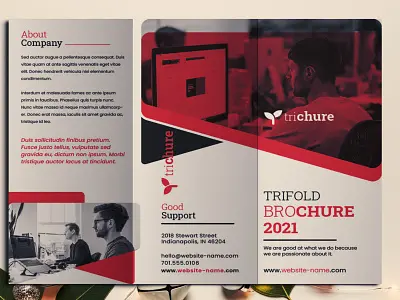
Bi-fold brochure format
The bi-fold format involves folding the paper in half, to make two equal-sized panels on each side. This fold creates four panels in total, two on the front and two on the back.
A bi-fold brochure is best for sharing simple messages or short and sweet pieces of content. It works well for event invites, newsletters, and promotional materials.
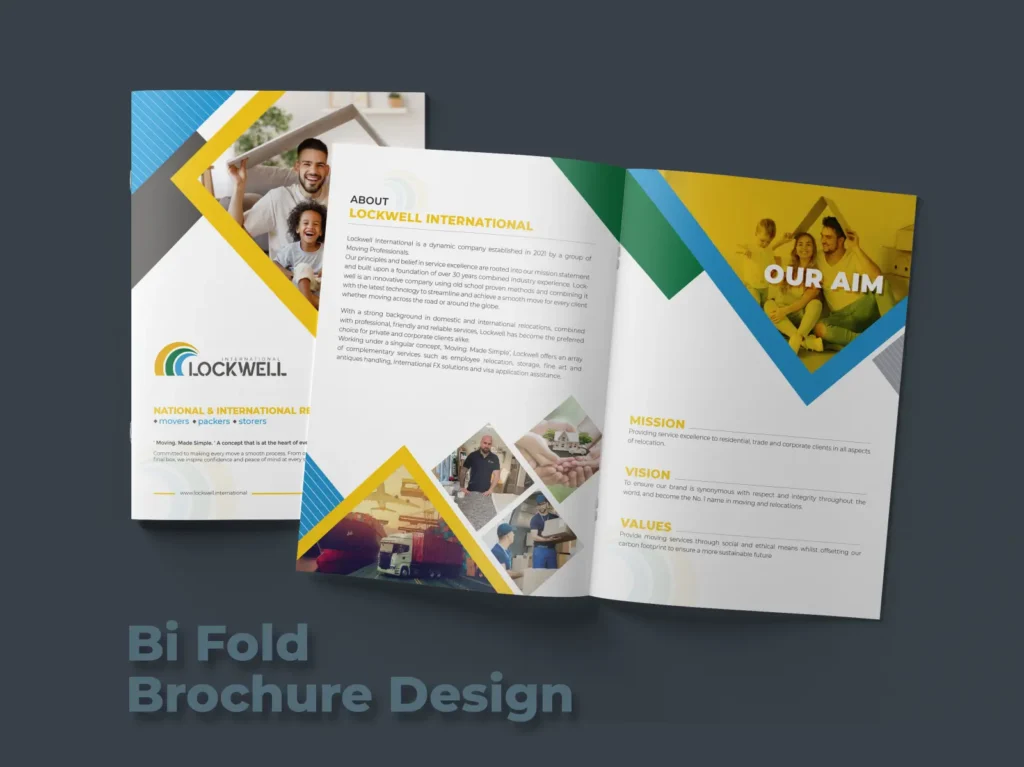
Z-fold brochure format
The z-fold involves folding the paper in a zigzag pattern, with each section folded in alternating directions to open like an accordion (hence why it’s sometimes referred to as “accordion fold”).
This dynamic fold format is perfect for brochures with a lot of information or step-by-step guides, as they provide a series of interconnected panels that can be revealed in sequence.
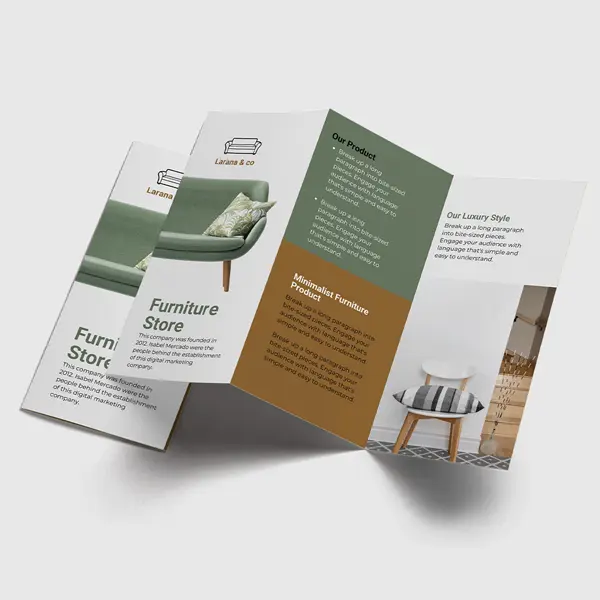
6. Review your brochure
After creating and formatting your brochure design or brochure template, you’ll need to share it with your team and/or stakeholders for review. But with so many moving parts, gathering feedback on your brochure designs can turn into a time-consuming task if not managed properly.
That’s why you need a top review and approval software like Filestage.
Filestage has been designed to prevent stress and confusion during your brochure review process by giving you a single space to share, review, and approve your designs. And because the tool can support a whole range of file formats (video, audio, live websites, PDFs, and more), you can use it to review all your other projects too!
Here are some of the ways that Filestage can streamline your brochure review process:
- Unlimited users – Invite teammates and clients to review and provide feedback right on top of your brochure (no account needed).
- User permissions – Make sure the right people can give and receive accurate feedback on your brochures with access controls and password protection.
- Actionable comments – Turn each collaborator’s comments on your brochure into a to-do list for enhanced efficiency.
- One-click approvals – Once you’re happy with the final brochure design, mark it approved and save or download as needed.
How to review brochures with Filestage
Want to get faster feedback and approvals on your brochures? Let’s look at how you can run your review process for your brochure online in five simple steps.
- Sign up to Filestage for free
- Create a project folder, give it a name, and upload files
- Invite reviewers and collaborators, or send them a link to the project
- Let collaborators add feedback and suggestions in the comments
- Upload new file versions as needed, and mark approved when ready
7. Print your brochure
After you get approval on your artwork, it’s time to get your new brochures ready for print!
It’s important to give everything a final once-over by checking your color, fonts, copy, and imagery to make sure they’re good to go before printing.
While you can print brochures in-house if budgets are tight, I’d strongly recommend going with a professional brochure printing service for the best results. Not only will this make sure your prints are clean and vibrant, you’ll also be able to choose from a variety of different paper stocks to give your brochure the perfect finishing touch!
Here are the most popular paper options to suit different brochures:
- Glossy paper – Perfect for brochures with vibrant colors and lots of photography. The only watchout here is this paper can be reflective and a bit tougher to read as a result.
- Matte paper – This minimalist paper stock is ideal for simple black-and-white designs or high-contrast color combinations.
- Uncoated paper – This versatile paper is easy to read and write on, which makes it especially handy for events. This isn’t the best option if you want crisp images and photos.
- Recycled paper – If you want your brochure to have a rustic, textured finish while being kinder to the environment, you can use paper made from post-consumer recycled materials.
Top tips for making an effective brochure
Here are three key tips to help you take your brochures to the next level every time.
1. Keep it simple
When making any brochure, simplicity is key. And this applies to design as well as messaging.
Resist the urge to overload your brochure with too much information and cluttered imagery, as this only creates a barrier for the reader.
Instead, use straightforward language to convey your message clearly and concisely. Limit the number of fonts, colors, and design elements to maintain a cohesive and professional look.
2. Consider user experience
Think about how your brochure will be used and make sure your design supports its intended purpose.
Choose a format and layout that aligns with the content and makes it easy for readers to navigate. You can even incorporate interactive elements like inserts or pop-outs for extra engagement.
3. Be playful with your brochure design
While this article has covered the basic steps for how to create a brochure, it’s up to you to put your own spin on the process.
Experiment with stunning design elements, unique layouts, typography, and graphics to make your brochure stand out. You can even create an entirely new fold that compliments your brand.
Final thoughts
I hope this article inspires you to make your next brochure the best one yet! And if you’d like to see how Filestage can help you review all your marketing materials, start your free trial today.



